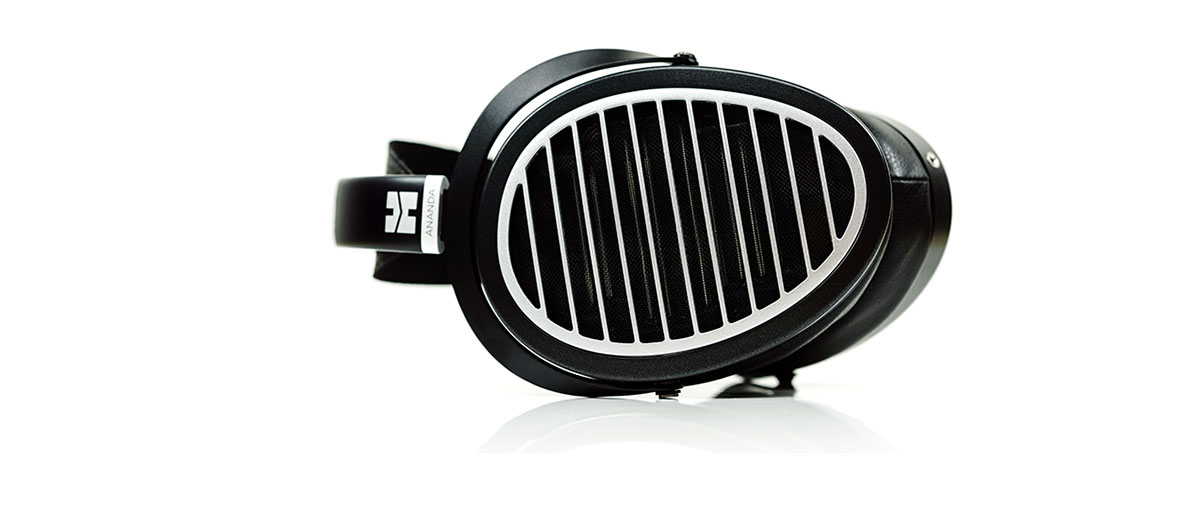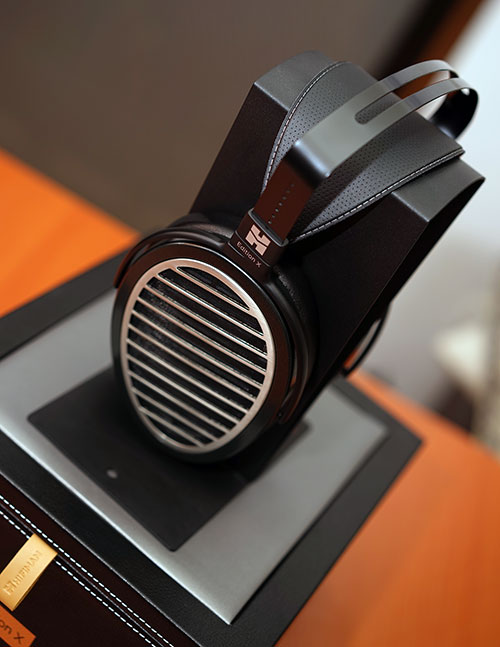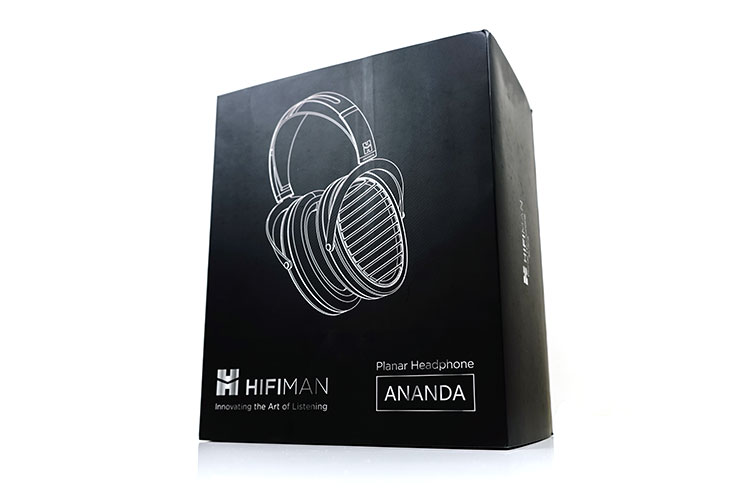Sound Impressions
Summary
The Ananda is a neutral to natural-sounding headphone drawing some low-end timbral warmth from a nuanced emphasis on the 100Hz to 1K response and a slightly laid-back midrange with only a slight bump for vocal presence. The lower treble remains fairly linear with the mids up to around 6-7k where it elevates fairly quickly and sustains to around 10k. Higher pitched instrumental timbre is thus a lot cleaner sounding and more to the fore on the Ananda.
Overall, the Ananda is a little more neutral in its tuning than the Edition X V2. It lacks the low-end body and weight of the V2 with a flatter more linear response from its mid-bass to lower mids. That linear performance produces a more balanced sound on the Ananda which I think gives it an edge over the older version.
The one thing I have noticed with Fang’s ever thinner driver materials is the speed. Each new headphone seems to sound faster with greater clarity than the previous and the Ananda is no exception. Whilst it may not have the same weight on the low-end as the V2, the speed and the definition of that low-end (and throughout) is noticeably superior.
Mix that in with a more balanced tuning and for my money the Ananda moves a little closer to a reference sound than previous iterations. Whilst still reasonably forgiving in tone this is a more mature tuning. One that sits more comfortably at the $1k marker than the older, and still more expensive, musical Edition X V2.
Soundstage
Definitely, the new driver design does seem to pull out a bit more detail. Particularly in the way it images and the treble articulation. Compared to the Edition X V2’s more centered and vocal focus, I was a lot more aware of staging width and imaging cues coming in far left and right.
Whilst the Ananda does not have the most powerful sounding low-end the perception of detail and depth is much improved over the Edition X V2. Instead of quantity, we have a little bit more quality and definition which in turn makes a lot of sub-100Hz detail much easier to pick up.
DJ Ten’s Nightwolf is a track I quite often use to gauge how well a headphone handles sub-100Hz presence and clarity because of that whopping sub-woofer style bass note intro. On the Edition X V2, the quantity was excellent if a little soft. However, on the Ananda that intro was much tighter sounding, delivering much more “shape” and clarity.
Bass
In terms of quantity, the low-end of the Ananda is south of neutral with a gentle roll-off starting as high as 200Hz. From 200Hz onwards the Ananda retains a very linear response with an excellent and very balanced transition into the lower mid.
Thus, there is a touch of warmth in the Ananda’s low-end but not as much quantity or physicality as the Edition X. The curve on both is actually quite similar up to 200Hz just the Ananda drops the dB by around 1-2dB. Instead, this is a lighter but faster and better-defined performance. I generally find Ananda’s low-end to show off an excellent level of detail despite the lack of power.
Mids
Mids are a little relaxed but open sounding on the Ananda. There is a slight but noticeable dip past 1k with a smaller nudge on the 2-4k range to deliver some vocal and upper mids presence.
Compared to the LCD-X, the Ananda mids do not sound as forward, a lot more neutral, and not quite as intimate sounding. The clarity and harmonic balance in the instrumental and vocal timbre though are excellent. Some of that general warmth and thickness of the Edition X V2 has been thrown out in favor of a leaner more accurate timbre. Combine that with the slightly better technical capability of the driver and it sounds cleaner with better instrumental separation and generally more open sounding.
Vocals have more neutral-sounding on the Ananda in terms of body with slightly more odd-harmonic presence than before Upper mids have a bit of a lift around 3-4k which favor higher-pitched vocals and percussion presence.
Treble
The upper mids to lower treble transition is very nicely balanced and quite smooth with no noticeable dips like the AEON Flow. You will not find any veil or lack of detail with a timbre that is neutral to slightly bright due to that upper harmonic order drawing from Ananda’s 7-10k emphasis.
It is not a harsh treble, not by a long shot but it does have more presence than the Edition X V2 and it does sound a little airier. On poor recordings, it might sound a little on the lean side but nothing as edgy sounding as the LCD-X treble tuning which I found much sharper on percussion timbre despite having more body.
Synergy
Efficiency
The Ananda, like the Edition X, is easily Hifiman’s most efficient full-size planar magnetic headphone in the market today. Cheaper alternatives such as the Sundara still require higher-powered amps or sources to sound optimal. Not so with the Ananda. It will run happily off a good DAP if you so need it.
Now, I am not suggesting your mobile phone is all you need at the extreme end, it is not quite that easy to drive. With my LG G6, it did feel like it needed more headroom and you will lose some essential dynamic range also. On that scale of things, something like the SINE from Audeze is going to be the better performer.
DAPs
Nor will all DAPs drive the Ananda to the pinnacle of its performance. The best performers we found were the iBasso DX200 with AMP 1 for power and clarity sub $1k and at summit-fi the Cayin’s N8 tube output for some delicious analog smoothness. The Lotoo Paw Gold Touch was delivered a very balanced and detailed sound though we did find the Sony 1Z to have just a bit more bass presence with the Ananda.
You will also find the Ananda may tax your DAPs power and volume just a little more than the average 30-40Ω dynamic driver. AKG’s efficient K872 and K812 headphones volume settings were about 10-15 steps lower than the Ananda (95-100) on Sony’s W1Z low gain 3.5mm setting as an example.
Compared to other planar headphones I did find the Audeze LCD-X to be slightly the easier of the two to drive though the Ananda was much more sensitive and easier to drive than the MrSpeakers AEON Flow.
Scaling
Quality Over Quantity
As with the Edition X V2, the ability to scale with more powerful amps 1W and beyond is not necessary and in our testing, we found that for power the Ananda will not scale quite in the same manner as the HE10000 and Susvara. That being said, and to quote my own words from the original Edition X V2 review back in Dec 2016;
However, reduced quantity does not negate the benefits of increased quality and not all amps are equal so I will say that a good amp will bring a qualitative improvement in the Edition X tonal response.
And thus, it is true also for the Ananda. Perhaps even more so because the one thing I found with the new Ananda tuning and technical performance was an increased level of transparency over the Edition X V2.
High-End
For example, both the Xi Audio Formula S and Auris Audio HE-2SE desktop amps have a smooth presentation with the tube-based HA-2SE a little more analog sounding. Both tuning differences I was able to hear clearly with the Ananda. If I had a preference for the more resolving Formula S which sounded a little more vivid and detailed than the HA-2SE.
Mid-Fi
You do not have to go high-end amping to get the desired response from the Ananda. The Burson Fun Class A with the V6 Classic opamps was a very smooth-sounding performer with the Ananda and it is well under $500.
ALO Audio’s Continental V5 portable amp is also more than capable if you want some sweet mids and not too bothered about fattening up the low-end. Actually, the V5 was my favorite for easy non-fatiguing listening sessions. It has a very sweet-sounding timbre with buttery smooth vocals and a very wide soundstage. The Ananda is also has a very low noise floor.
If you want something a bit cleaner and punchier then iFi’s xCan is also more than capable with the Ananda. There is no shortage of power with plenty of dynamic range with this pairing. It is a bit more neutral sounding than the V5 when paired with the Ananda but it has a punchier bass and a livelier treble which some might prefer.
Select Comparisons
Hifiman Edition X V2
$1299
Technical
The V2 is rated the exact same as the Ananda at 25Ω and 103dB. It will drive the same and demand equal volumes on almost all sources tested so you will not need more juice to drive the Ananda.
The key differences are in the presentation (see below) and the build quality. Some might find the Edition X’s headband system a little more comfortable because of the additional swivel joint for more lateral movement but I personally find the Ananda a little sturdier and slightly better build quality overall. The Edition X V2 uses the older 2.5mm dual entry jack system compared to the newer 3.5mm TRS jacks of the Ananda.
The weight, cups form factor, and pads remain unchanged. However, the NsD driver system on the Ananda is new as is the lighter thinner structure of the diaphragm itself.
Performance
I can see why some are saying tonally there is not a huge difference between these two headphones. However, there are differences for me in both the tuning bias and level of technical capability that would make me pick one over the other.
For one, the low-end quantity is about 2-3dB higher on the Edition X V2 compared to the Ananda. You will get a bit more body and slightly more warmth with the Edition X V2 bass performance producing what I would consider a more musical bass response than the more neutral quantity level of the Ananda. If you prefer some punch in your bass then the Edition X V2 will be the better choice.
The Ananda low-end is a touch more linear in its curve with a smoother upper bass to lower midrange transition. The instrumental timbre is more neutral bodied on the Ananda and vocals are not quite as forward as on the Edition X V2 but sound cleaner and perhaps a little clearer. Percussion timbre has a bit more snap and presence on the Ananda with what seems to be more upper mids and lower treble emphasis compared to the Edition X V2.
Of the two the Ananda has a slightly better balance overall. It also offers a little more in terms of detail and stronger imaging with a better top-end presence. It just sounds the more open and quicker-paced of the two headphones with better detail retrieval and a little more headroom.
Audeze LCD-X
$1299
Technical
We are pulling the Fazor-tuned LCD-X into this mix because of Audeze’s new lower price of $1299 for what is an excellent if a slightly aging set of planar headphones.
When I say aging, I mean in terms of addressing the bug-bears we have about planar weight. At 600g the LCD-X is much heavier than the 399g of the Ananda. You will feel that difference on your head though the very nice deep-set lambskin pads do help somewhat.
At 20Ω and 103dB compared to the Ananda’s 25Ω and 103dB they are both very easy to drive and among the most efficient full-size planar magnetic headphones out there in the market today. Mind you, I did find the LCD-X marginally louder at similar volumes on our tested amps (HA-2SE, Burson Fun) and sources (Lotoo Paw Gold Touch and Cayin N8).
Performance
Whilst tonally I would say both are fairly neutral there are some key differences between them that stand out immediately. The first was the harmonic balance and how the midranges are perceived. On the LCD-X percussion has more bite and sounds a little splashier and more to the fore than the Ananda. It also sounds a touch harder-edged on vocal timbre though vocals are more forward and full-bodied than the Ananda.
The Ananda’s midrange drops back a little more than the LCD-X so vocals do not have the same level of physicality and presence but they are a little smoother sounding. The LCD-X holds its loftier elevation just a bit longer from 200Hz to 2k whereas the Ananda drops away post 1k before it bumps a bit from 3-4k. Thus, guitar work will have a bit more forward presence, body, and crunch on the LCD-X but overall, it sounds more intimate.
The low-end on both is quite neutral to slightly rolled-off though I would say the LCD-X has a few dB more in terms of quantity across the board and will come across as the punchier of the two. That being said I think the Ananda sub-bass has the better definition and control over the LCD-X performance.
The LCD-X has a 4-5k bump which might explain more percussion presence as well as a more energetic 6-7k lift that would go some way to understanding that harder edge or more odd-harmonic overtone on some higher-pitched instrumental timbre and vocals.
Overall, I find the Ananda the more balanced of the two headphones with a slightly more pleasing treble timbre. However, the LCD-X does retain that more aggressive and forward sounding lower-midrange that plays well with rock male vocals and guitar work.
MrSpeakers AEON Flow
$799
Technical
Whilst still being classed as a full-sized open-back planar headphone design, the AEON Flow is the smaller of the two headphones. The plus side to that is that it is lighter at 321g compared to 399g.
The pressure balance is very good actually, marginally better than the Ananda and it does have additional swivel and deeper plusher pads that are shaped just right for your ears. This is a well-made headphone.
The AEON Flow, however, is not as sensitive or as easy to drive as the Ananda by some distance. The sensitivity rating is 92dB which is an 11dB gap from the Ananda. You will need more juice and gain to drive the AEON Flow to a similar level.
You will also need a more neutrally tuned and clean-sounding amp to get the synergy right. The Cayin’s N8 sounds great in solid-state with the AEON Flow but the tube output is much too soft and casts a veil on the AEON Flow performance. The Ananda pairs much better with the tube output of the N8, perhaps an ideal pairing actually.
Performance
A hugely different experience between these two headphones. The AEON Flow is much warmer and even-harmonic biased with a bigger mid-bass lift from 100-400Hz whereas the Ananda is much more linear and flatter from 200Hz to 1k.
The AEON Flow also has a slow but steady descent from that midbass peak around 400Hz down to almost 5k with only a marginal bump around 1-2k for vocal presence. It will sound more euphonic or lush in tone than the neutral cleaner midrange of the Ananda.
Instrumental timbre might have the better body on the Flow but its imaging and separation of instruments are not quite as accurate or as precise as on the Ananda. Instrumental notes on the AEON Flow might sound overly rounded and soft on the AEON Flow for those who like a bit more upper midrange presence. For sure, the Ananda has more bite and presence in the upper mids and lower treble but less body and richness compared to the AEON Flow.
The Ananda does sound perceptibly more spacious and detailed to my ear but it is not quite as forgiving or as intimate as the AEON Flow. For those who don’t mind giving up a little treble-induced clarity and prefer a richer lower-end body then the AEON Flow is a good choice.
Our Verdict
With the Ananda, slow but surely the new Hifiman house sound is beginning to take shape. With a little of the previous Edition X V2 musicality shaved off in favor of a more balanced and dare I say it, slightly more reference type sound the Ananda represents possibly one of the companies most mature offerings to date.
The enhanced build quality also seems to suggest that this new form factor will be here for some time also in a lot of the newer Hifiman headphones. Possibly not all given the Arya has the old headband edition but a substantial majority at least. You do lose a little in terms of absolute fit but the large cups seem to negate any battles nicely for a sweet spot on your head.
And yes. $999 is a welcome price drop, very welcome indeed. Sub-$1000 has become a much more competitive territory these days for planar designers with just about everyone trying to reclaim it in the last 18 months or so. The Ananda may very well be one of the best-sounding ones yet and well worth a demo if you are shopping on that budget.
Hifiman Ananda Technical Specifications
- Driver Type: Planar
- Design: Over-Ear (Circumaural)
- Earcup Style: Open-Back
- Frequency Response: 8 Hz to 55 kHz
- Sensitivity: 103 dB
- Impedance: 25 Ohms
- Cable Length: 1.5 m
- Weight: 399 g







